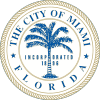Greater Downtown Miami
Downtown Miami | |
|---|---|
Neighborhood | |
 Downtown Miami in 2013 | |
| Nicknames: Downtown, Central Business District | |
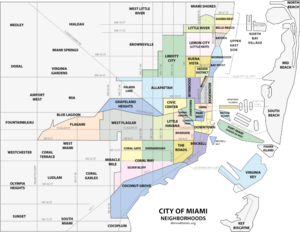 Downtown neighborhoods within the City of Miami | |
| Coordinates: 25°46′26″N 80°11′24″W / 25.774°N 80.190°W | |
| Country | United States |
| State | Florida |
| County | Miami-Dade County |
| City | Miami |
| Settled | 1830s |
| Incorporated into the City of Miami | 1896 |
| Subdistricts of Downtown | Neighborhoods
|
| Government | |
| • City of Miami Commissioner | Ken Russell (D) |
| • Miami-Dade Commissioners | Vacant |
| • 305, 786 | |
| Website | www |
Downtown Miami is the urban city center of Miami, Florida, United States. The city's greater downtown region consists of the Central Business District, Brickell, the Historic District, Government Center, the Arts & Entertainment District, and Park West. It is divided by the Miami River and is bordered by Midtown Miami's Edgewater, and Wynwood sections to its north, Biscayne Bay to its east, the Health District and Overtown to its west, and Coconut Grove to its south.
Downtown Miami is the core of the Miami metropolitan area, the nation's ninth-largest and world's 34th-largest metropolitan area with a population of 6.158 million people.
Within Downtown Miami, Brickell Avenue and Biscayne Boulevard are the main north–south roads, and Flagler Street is the main east–west road. The Downtown Miami perimeters are defined by the Miami Downtown Development Authority as the 3.8-square-mile (9.8 km2) area east of Interstate 95 between Rickenbacker Causeway to the south and the Julia Tuttle Causeway, which connects Miami and Miami Beach, to the north.
The area is a cultural, financial, and commercial center of the Miami metropolitan area, tracing its present-day history back to the 19th century. In recent years, Downtown Miami has the
History
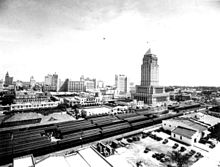
Downtown Miami is the historic heart of
As of 2009, there are approximately 71,000 year-round residents in Greater Downtown (including Downtown's Brickell, Park West, and Arts & Entertainment District neighborhoods), with close to 200,000 populating the Downtown area during the daytime, making Downtown Miami one of the most populous downtowns in the U.S. after New York City and Chicago.[4] With recent mass construction of high-rise residential buildings and office towers, Downtown has experienced large growth, with new shops, bars, parks, and restaurants opening up, attracting many new residents.
Along with Brickell, Downtown has grown from 40,000 residents in 2000, to over 70,000 in 2009, making it one of the fastest-growing areas in Florida. It was estimated in February 2010, that about 550 new residents move to the Downtown area every month.[5] As of 2009, over 190,000 office employees work in Downtown and Brickell.[6]
Downtown is served by the
Neighborhoods
Downtown Miami is centered on the
Central business district ("downtown")

The
The CBD is directly served by the
Miami Jewelry District
The Miami Jewelry District is a sub-neighborhood within the Central Business District historically known for its numerous jewelry stores,
Brickell
Arts and Entertainment District
The
Park West
Park West is the neighborhood just west of
Demographics
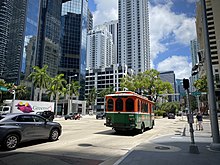
| Census | Pop. | Note | %± |
|---|---|---|---|
| 1990 | 36,140 | — | |
| 2000 | 40,556 | 12.2% | |
| 2010 | 66,769 | 64.6% | |
| 2018 (est.) | 92,235 | 38.1% | |
| source:[10] | |||
As of 2010, the population of Downtown Miami was 65,696 people, with a population density of 27,487 per square mile. In the 2010 US Census, the racial makeup of Downtown was 57.6%
In 2000, Downtown had a population of 39,176 residents, with 15,333 households in 1990 with an average of 2.2 residents per household, 17,130 households in 2000 with a household average of 2.1, and 33,600 households in 2009 with a household average of 2.0 residents. By 2014, the population of Downtown is expected to grow to 85,000 with 42,400 households. The median household income was $29,396 in 2000 and $40,180 in 2009.[11]
The zip codes for Downtown include 33128, 33130, 33131, and 33132. The area covers 2.117 square miles (5.48 km2). As of 2000, there were 6,451 males and 4,792 females. The median age for males were 34.5 years old, while the median age for females were 35.8 years old. The average household size had 1.9 people, while the average family size had 2.8 members. The percentage of married-couple families among all households was 25.5%, while the percentage of married-couple families with children (among all households) was 8.5%, and the percentage of single-mother households among all households was 5.8%. 15.3% of the population was in correctional institutions. 1.6% of the population was in other group homes. The percentage of never-married males 15 years old and over was 27.6%, while the percentage of never-married females 15 years old and over was 13.9%.[12]
As of 2000, the percentage of people that speak English not well or not at all made up 23.1% of the population. The percentage of residents born in Florida was 26.9%, the percentage of people born in another U.S. state was 25.0%, and the percentage of native residents but born outside the U.S. was 6.4%, while the percentage of foreign born residents was 41.7%.[12]
2009 Census projections indicate that the area's residential base has increased from 40,000 to 71,000 since 2000, with an expected Downtown population of 85,000 by 2014. As of 2006, 189,164 residents live in the immediate Downtown/Brickell area.[5][13]
Transportation
Public transportation in the Downtown area is used more than in any other part of Miami and is a vital part of Downtown life.
Downtown Miami is served by
Metrorail:
- Government Center(NW 1st Street and 1st Avenue)
- Brickell(SW 11th Street and 1st Avenue)
- Historic Overtown/Lyric Theatre(NW 8th Street and 1st Avenue)
Metromover:
- Downtown/Inner Loop
- Omni Loop
- Brickell Loop
Metrorail has stops throughout Miami with connections to
As an urban and
Recently, the City of Miami, along with the Downtown Development Authority, has begun bicycle initiatives promoting citywide bike parking and
Tri-Rail expansion
In the 2025 and 2030 long range transportation plans, Miami's
Tri-Rail service on the FEC line would bring Tri-Rail to Downtown's transit hub,
Taxis
Taxis are popular in Downtown, especially from Downtown to South Beach, Design District or to Coconut Grove. Since many Downtown residents choose to not have cars, taxis are also popular for rides within Downtown neighborhoods, especially after midnight when the Metromover stops running. Taxis can be hailed on the street, or phoned.
Economy

Downtown is home to many companies, corporations and organizations. Downtown has about 20 million square feet (1,900,000 m2) of office space, and is the central financial and business hub of
Public organizations with their main offices in Downtown include, the central offices of the Beacon Council, the Downtown Development Authority,
Consulates
Several countries have
- Argentina[20]
- Bahamas[21]
- Bolivia
- Brazil[22]
- Chile[23]
- Colombia[24]
- Dominican Republic[25]
- Ecuador[26]
- France[27]
- Germany[28]
- Guatemala[29]
- Haiti[30]
- Israel (Consulate-General of Israel to Florida & Puerto Rico)[31]
- Jamaica[32]
- Japan[33]
- Mexico
- Netherlands[34]
- Paraguay[35]
- Peru[36]
- Spain
- Suriname
- Turkey
- Trinidad and Tobago[37]
- United Kingdom[38]
- Uruguay
Japan first opened its consulate in Miami in 1992. As of 1992 this consulate gives logistical support to Japanese embassies in the Caribbean and Latin America. Japan opened a consulate in Miami after Japanese investors purchased several major real estate properties in Florida.[39]
Chambers of commerce
Downtown is also home to many international chambers of commerce, these include:
- British American Business Council
- Italy-America Chamber of Commerce
- Spain-United States Chamber of Commerce
- German American Business Chamber
- Chilean-American Chamber of Commerce
- French American Chamber of Commerce.
Historic districts

Downtown has three
The
The Lummus Park Historic District is west of Downtown in the neighborhood of Lummus Park. It is west of I-95 surrounding Lummus Park along the Miami River. The historic district was designated historic in 1988 and then expanded in 2006. The area is 260 acres (1.1 km2) large with 43 different buildings mostly owned by private entities and the local government. Prominent styles include late 19th and early 20th-century revival styles, Art Deco, and Bungalow style, with prominent periods of 1900–1924 and 1925–1949.
Parks

Downtown's largest and most popular parks are
Other parks in the Downtown area include:
- Fort Dallas Park, Central Business District
- Lummus Park, Central Business District
- Paul S. Walker Park, Central Business District
- Joan Lehman Sculpture Plaza, Central Business District
- Robert F. Clark Plaza, Central Business District
- Southside Park, Brickell
- Simpson Park, Brickell
- Alice Wainwright Park, Brickell
- Brickell Park, Brickell
- Miami Circle, Brickell
- Brickell Key Park, Brickell
- Brickell Plaza Mini Park, Brickell
Government and infrastructure
As the
Downtown is home to many city, county, state, and federal courthouses, jails, judge offices, and law firms. Some of the courthouses in Downtown are the Dade County Family Court, U.S. Court of Appeals Judge, U.S. District Court Clerk,
The United States Postal Service operates two post offices in Downtown. They are the Brickell Post Office and the Flagler Miami Post Office.[45][46] The Federal Detention Center, Miami, operated by the Federal Bureau of Prisons, is located in Downtown.[47]
Fire stations
The
- Fire Station # 1 – 144 NE 5th Street – Midtown/Overtown (Downtown)
- Fire Station # 2 – 1901 N Miami Avenue – Wynwood/Edgewater
- Fire Station # 3 – 1103 NW 7th Street – Little Havana/Overtown
- Fire Station # 4 – 1105 SW 2nd Avenue – Brickell/The Roads (Downtown)
Cost of living
The average apartment sale price was $347,729 in 2010, up 15% from 2009, with the average apartment price at $300 per square foot. During the
In July 2011, Downtown's office vacancy rate was reported at 21% dropping from a high of 26% in mid-2010. Downtown also reported an average commercial asking rate of $36.33, making it the eighth-highest in the nation after
Downtown has over 6,000 hotel rooms in numerous hotels. Downtown has Miami's largest concentration of hotel rooms, and is the city's hub for business travellers. Many of these hotels are geared for business travellers, mostly along Brickell Avenue, some for luxury leisure stays, and others as bargain tourist hotels.
Retail
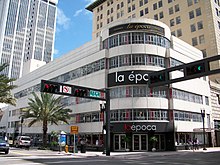
Historically,
After many years of decay, recently, much focus has been placed on revitalizing Flagler Street to its former grandeur. In recent years, a renewed investment interest has been placed on Flagler Street, and many new restaurants and stores have opened up, new landscaping and pavers have been placed, as well as enforced security and tourist guides. Three new pocket parks opened on Flagler St in 2009, Paul S. Walker Park, Robert F. Clark Plaza, and the Joan Lehman Sculpture Plaza. These new parks have brought more green space, benches, art, and rest areas to the street.
Besides Flagler Street, Downtown has two other major shopping areas, Bayside Marketplace and Mary Brickell Village in Brickell. Bayside Marketplace was built in 1987, and is one of Miami's most visited tourist attractions averaging over 15 million visitors a year. It is an outdoor shopping mall overlooking Biscayne Bay at Bayfront Park. Bayside Marketplace has many national retail chains, as well as local Miami stores. Mary Brickell Village is on Miami Avenue and SE 10th Street in Brickell. Mary Brickell Village is a major nightlife area and has many of Miami's upscale bars and restaurants that stretch along Miami Avenue from around SE 6th Street to Broadway (SE 15th Road).
Education
Public schools
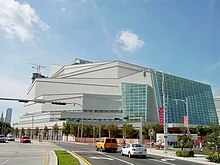

Miami-Dade County Public Schools operates Downtown Miami's public schools, which include:
Elementary schools
- Downtown Miami Charter School
- Southside Elementary School
- Miami Children's Museum School
- Bridgepoint Academy of Greater Miami (Charter)
High schools
- Law Enforcement Officers' Memorial High School, a magnet school
- New World School of the Arts, an arts magnet school
Public school zoning
Downtown children are zoned based on the neighborhood they live in within Downtown, roughly split into Brickell, Central Business District (CBD), and Arts & Entertainment District/Edgewater.[53]
- Elementary schools:
- Southside Elementary School, for Brickell children
- Riverside Elementary School, for CBD children
- Frederick Douglass Elementary School, for CBD children
- Phillis Wheatley Elementary School, for Arts & Entertainment District and Edgewater children
- Middle schools:
- Shenandoah Middle School, for Brickell children
- José de Diego Middle School, for CBD, Arts & Entertainment District and Edgewater children
- High schools (open to all Downtown residents):
- Young Women's Preparatory School, all-girls
- Young Men's Preparatory School, all-boys
- Booker T. Washington High School
Private schools
Plans are currently underway for a 1,700-student
- First Presbyterian International Christian School
- Gordon Day School (Jewish)
- Prima Casa Montessori School
Colleges and universities
- Florida International University (Downtown Center), a public university at 1101 Brickell Avenue
- Miami Dade College (Wolfson Campus), a public college
- Miami International University of Art & Design, a private university
- Miami Culinary Institute, a public college
- University of Miami, highly ranked private research university in neighboring Coral Gables
Cultural institutions
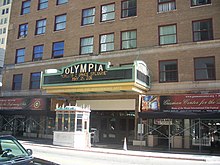

Museums and historic sites
- Pérez Art Museum Miami
- Historical Museum of Southern Florida
- Miami Children's Museum
- Wagner Home
- Freedom Tower
- City of Miami Cemetery
- Downtown Miami Historic District
- Lummus Park Historic District
- Miami Circle
Theatres and performance arts
- Adrienne Arsht Center for the Performing Arts
- Ziff Ballet Opera House
- Knight Concert Hall
- Florida Grand Opera
- Gusman Center for the Performing Arts
- Miami City Ballet
- Miami Wind Symphony
Libraries
- Miami Main Library
Places of worship

- Central Baptist Church (Built in 1925)
- First Church of Christ Scientist (1925)
- First Presbyterian Church (1898)
- First United Methodist Church (1966)
- Gesu Catholic Church (1896)
- Greater Bethel AME Church(1927)
- Miami Central Spanish Seventh-day Adventist Church (Miami, Florida) (1925)
- St. Jude Catholic Church (1946)
- Temple Israel of Greater Miami (1926)
- Trinity Episcopal Cathedral(1925)
- Immanuel Lutheran Church
- Temple Israel of Greater Miami
- Central Korean Presbyterian Church
- The Shul of Downtown and Brickell
Bookstores
- Books and Books – Wachovia Financial Center
- Miami Book Fair International, an annual literary festival held at Miami Dade College
Festivals and events
- DWNTWN Concert Series, free performances every 2nd Friday of the month at 5:30pm, Bayfront Park
- New Year's Big Orange Drop, Bayfront Park
- Miami Marathon, marathon held in January
- Ultra Music Festival, electronic music festival held in March
- Miami International Film Festival, held in March
- Winter Music Conference, held in March
- Independence Day Celebration, Bayfront Park
- Miami Book Fair International, literary festival held in November
- Art Basel Miami, art exhibitionheld in December
- Miami International Boat Show
- The Arts Of Storytelling, held in March
- The Best of the Best Reggae Concert
Sports facilities
- American Airlines Arena, home of the Miami Heat
Downtown skyscrapers

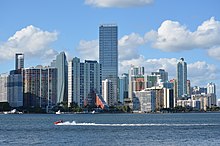
Office towers
- Four Seasons Hotel Miami
- Southeast Financial Center
- Miami Tower
- One Biscayne Tower
- 1450 Brickell
- 701 Brickell Avenue
- Brickell Financial Centre
- Brickell Arch
- Sabadell Financial Center
- Brickell Bay Office Tower
- Latitude One
- SunTrust International Center
- Alfred I. DuPont Building
- Miami Center
- Courthouse Center
- Museum Tower
- Dade County Courthouse
- New World Tower
- Stephen P. Clark Government Center
- Met 2 (Wells Fargo Center)
Residential towers
- 900 Biscayne Bay
- Ten Museum Park
- 1800 Club
- Wind
- Marinablue
- One Miami East Tower
- One Miami West Tower
- Opera Tower
- Quantum on the Bay North Tower
- Quantum on the Bay South Tower
- The Ivy
- Marquis Miami
- Mint
- 50 Biscayne
- Met 1
- The Loft 2
- Everglades on the Bay North Tower
- Everglades on the Bay South Tower
Hotel towers
- Four Seasons Hotel Miami (Brickell)
- Hotel InterContinental
- The Grand Doubletree
See also
References
- ^ "2016; Greater Downtown Miami Demographics" (PDF). miamidda.com. Applied Research and Analytics. Retrieved March 12, 2020.
- ^ "2016; Greater Downtown Miami Demographics" (PDF). miamidda.com. Applied Research and Analytics. Retrieved March 12, 2020.
- ^ a b "Archived copy" (PDF). Archived from the original (PDF) on October 24, 2018. Retrieved October 24, 2018.
{{cite web}}: CS1 maint: archived copy as title (link) - ^ "Miami Downtown". Archived from the original on December 15, 2014. Retrieved November 28, 2014.
- ^ a b http://www.cpnfromtheinside.com/2009/07/study-confirms-downtown-miami-is-coming-to-life.html. Retrieved July 27, 2009.
{{cite web}}: Missing or empty|title=(help)[dead link] - ^ Miami Herald http://www.miamiherald.com/103/story/1030124.html. Retrieved May 4, 2009.
{{cite web}}: Missing or empty|title=(help)[dead link] - ^ "Biscayne Boulevard Improvements". Archived from the original on August 9, 2014. Retrieved March 20, 2011.
- ^ "Miami Worldcenter". miamiworldcenter.com.
- ^ a b "Mapping the 2010 U.S. Census". The New York Times. December 13, 2010.
- ^ "Population and Demographics Profile" (PDF). Miami DDA. Archived from the original (PDF) on October 24, 2018. Retrieved October 23, 2018.
- ^ "Archived copy" (PDF). Archived from the original (PDF) on March 20, 2012. Retrieved July 15, 2011.
{{cite web}}: CS1 maint: archived copy as title (link) - ^ city-data. Retrieved August 31, 2009.
- ^ http://www.miamidda.com/business-demographics.html. Retrieved June 13, 2008.
{{cite web}}: Missing or empty|title=(help)[dead link] - ^ Do bicyclists and pedestrians outnumber cars on the Rickenbacker Causeway on weekend mornings? | Transit Miami Archived January 6, 2011, at the Wayback Machine
- ^ Miami Downtown Development Authority hashing out plans to bring Tri-Rail downtown
- ^ Miami Downtown Development Authority Archived July 13, 2011, at the Wayback Machine. Miamidda.com. Retrieved on 2013-08-16.
- ^ "Vector Group Ltd". www.vectorgroupltd.com.
- ^ "Contact Us." LTU International. March 3, 2000. Retrieved on June 21, 2009.
- ^ "Company Directory." Stanford Financial Group. July 8, 2000. Retrieved on June 21, 2009.
- Consulate-General of Argentina in Miami. Retrieved on January 30, 2009.
- ^ "Contact & Overseas Missions Archived 2009-02-16 at the Wayback Machine." Ministry of Foreign Affairs (The Bahamas). Retrieved on January 31, 2009.
- Consulate-General of Brazil in Miami. Retrieved on January 30, 2009.
- ^ "Oficinas Consulares en Estados Unidos."
- ^ "- Consulado de Colombia en Miami". miami.consulado.gov.co.
- Consulate-General of the Dominican Republic in Miami. Retrieved on January 31, 2009.
- Embassy of Ecuador in Washington, DC. Retrieved on January 30, 2009.
- Consulate-General of France in Miami. Retrieved on January 30, 2009.
- Consulate-General of Germany in Miami. Retrieved on January 30, 2009.
- Consulate-General of Guatemala in Denver. Retrieved on January 31, 2009.
- Embassy of Haiti in Washington, DC. Retrieved on January 30, 2009.
- ^ "Consulate-General of Israel to Florida & Puerto Rico."
Israel Diplomatic Network. Retrieved on January 30, 2009.
- ^ "Contact."
Consulate-General of Jamaica in Miami. Retrieved on January 30, 2009.
- ^ "Contact."
Consulate-General of Japan in Miami. Retrieved on January 30, 2009.
- ^ Home page.
Consulate-General of Netherlands in Miami. Retrieved on January 30, 2009.
- ^ "El Consulado Retrieved on January 30, 2009.
- ^ "Datos Generales Archived January 10, 2009, at the Wayback Machine
- ^ "Consulate General of the Republic of Trinidad and Tobago Miami Archived 2011-05-12 at the Wayback Machine." Retrieved on May 18, 2011
- ^ "Miami Archived 2009-02-21 at the Wayback Machine." UK in USA. Retrieved on January 30, 2009.
- ^ "JAPAN OPENS CONSULATE TO SERVE SOUTH FLORIDA." Miami Herald. January 10, 1992. 1C Business. Retrieved on January 17, 2012.
- ^ "National Register of Historical Places - FLORIDA (FL), Dade County". www.nationalregisterofhistoricplaces.com.
- ^ Miami Police Department. Miami-police.org. Retrieved on 2013-08-16.
- ^ Miami-Dade County - Clerk of Courts. Miami-dadeclerk.com (May 29, 2013). Retrieved on 2013-08-16.
- Miami-Dade County. Retrieved on March 12, 2010.
- ^ U.S. Marshals Service, Courthouse Locations. Usmarshals.gov (June 3, 2004). Retrieved on 2013-08-16.
- U.S. Postal Service. Retrieved on December 30, 2009.
- U.S. Postal Service. Retrieved on December 30, 2009.
- ^ "FDC Miami Contact Information." Federal Bureau of Prisons. Retrieved on December 30, 2009.
- ^ "DDA Report: Downtown Miami Condos Rise in Sales, Price and Absorption". Pordes Residential. March 2, 2011. Retrieved November 20, 2015.
- ^ "Archived copy" (PDF). Archived from the original (PDF) on May 16, 2011. Retrieved February 26, 2011.
{{cite web}}: CS1 maint: archived copy as title (link) - ^ Patel, Julie. "An insurance option worth considering".
- ^ U.S. Office Market Records Largest Quarterly Decline in Vacancy Rates Since Mid-2007; Miami Posts Strongest Vacancy Drop - WORLD PROPERTY CHANNEL Global News Center Archived March 18, 2012, at the Wayback Machine. Worldpropertychannel.com. Retrieved on 2013-08-16.
- ^ Freedom Tower in Miami - Guide to Miami's Freedom Tower Archived October 1, 2011, at the Wayback Machine. Miami.travelape.com (April 24, 2009). Retrieved on 2013-08-16.
- ^ Services Near You Archived July 19, 2011, at the Wayback Machine




